The installation of a monument to the famous Soviet and Russian arms designer, M.T. Kalashnikov, was followed by a whole chain of scandals. In 2017 Yuri Pasholok pointed out an unfortunate mistake that was made by the sculptor, who placed an exploded diagram of a Sturmgewehr on the monument to the creator of the AK in Moscow. All of this led back to the question that was answered for anyone who is even slightly interested in the history of small arms long ago. Nevertheless, serious flame wars broke out, so it's time to, once again, explain the differences in the two designs, and how it turned out that an unknown sergeant's gun ended up as a symbol of the USSR, which is still relevant in modern Russia.
Intermediate cartridge
So, what is the relationship between the Soviet assault rifle and the Sturmgewehr? Usually, people with little understanding of the issu,e and people with little understanding in general, focus on the outward appearance. This is understandable: the purpose of the weapons was the same, the era was the same, the layout, due to the similar solutions and purpose, was similar. Except, this layout was in use long before the Sturmgewehr came into existence. Schmeisser was not a pioneer here.

The light machinegun (or automatic rifle) pictured above is a design by an american, Isaac Lewis, in 1923. This rifle was not produced in great numbers, but, at the time, it was very well known, and tested in many countries. If you take out the bipod and the dimensions, determined by the full rifle cartridge, what do you see? The same pistol grip, the same detachable box magazine on the bottom, the same upper gas system, a long stroke piston, and a rotating bolt: hello, AK!
Let's move onto the round. Schmeisser had nothing to do with the creation of the intermediate round. In 1940, the HWaA (Heereswaffenamt, the Wehrmacht's Directorate of Armament of the Land Forces) distributed tactical-technical requirements for a new automatic weapon, using a cartridge that was already designed by the Polte company. Work on a special intermediate round began in Germany in 1935, and in 1918 in the rest of the world.
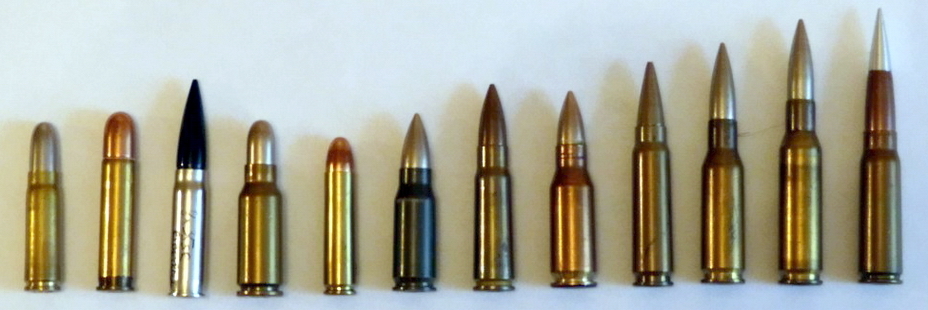
The USSR was fully aware of this work. In the mid-1930s, famous arms designer and historian V.E. Markevich called to produce submachine guns (machine carbines) that used miniaturized rifle rounds, instead of pistol rounds, pointing to .25 Remington as a good starting point. Why did this idea of an intermediate round misfire, both in 1918 and 10-15 years later? Of course, we cannot know the precise reasons, but it's possible to come up with reasonable guesses.
First of all, senior army staff tend to be conservative, and don't like to risk their careers for novelties of uncertain benefit. Most of the generals of the time grew up in the era of rifles with magazine cutoffs, firing in volleys, and bayonet charges. The idea of arming a rank and file infantryman with rapid fire automatic weapons was a strange idea to most of these commanders.
Secondly, despite the obvious economy in materials and spending on production of each individual round and delivery to the battlefield, the increased consumption of ammunition compared to bolt action rifles would mean increased strain on production and logistics.
Thirdly, by the end of the First World War, the machinegun became an irreplaceable part of the infantry's armament. Using a reduced power version of a rifle cartridge in machineguns, especially heavy ones, meant reduction in firepower against all targets. This meant that the new «weaker» round would have to be used alongside the full strength one, instead of replacing it, which meant more strain on logistics.
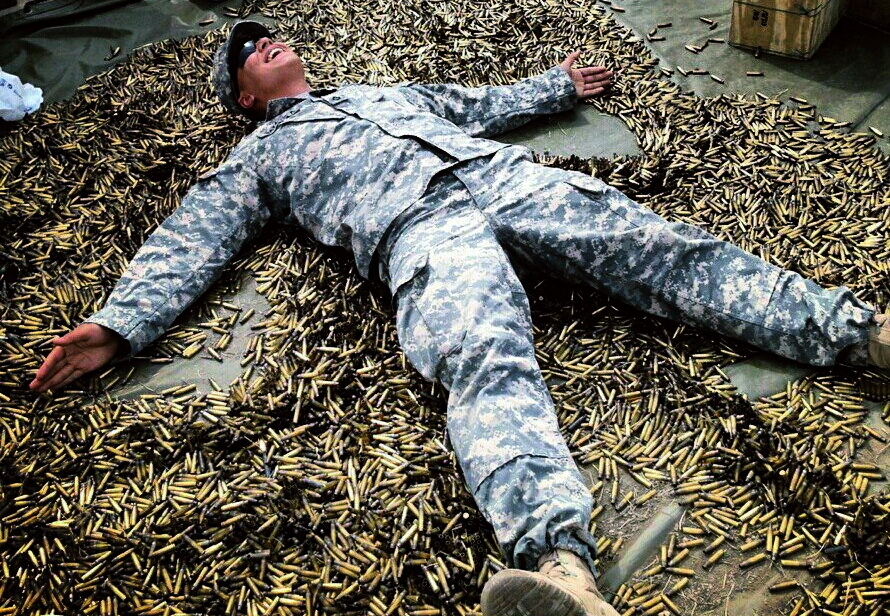
Finally, until the late 1930s, an infantryman's list of potential targets included not just enemy infantry, but also targets like horses, armoured cars, and low flying airplanes. Using a reduced power round could radically decrease infantry's effectiveness against these kinds of targets, which was also unacceptable. For that reason, the USSR chose a semiautomatic rifle as a standard infantry weapon, and the «progressive» Germans stuck with a regular Mauser bolt-action rifle, hedging the infantry's firepower on a single machinegun.
The start of WWII, with its increased mechanization and rapid operations, quickly and decisively showed that, when masses of infantry collide, it's not precision or power of each individual round that matters, but the amount of them fired towards the enemy. According to data gathered after the war, each dead soldier cost thousands, or even tens of thousands of fired rounds. In addition, cavalry was departing from the battlefield, and further development of armour and aircraft made them immune to even the most powerful rifles. To be fair, the Germans understood this in the mid-1930s, which is why they began working on a reduced power round.
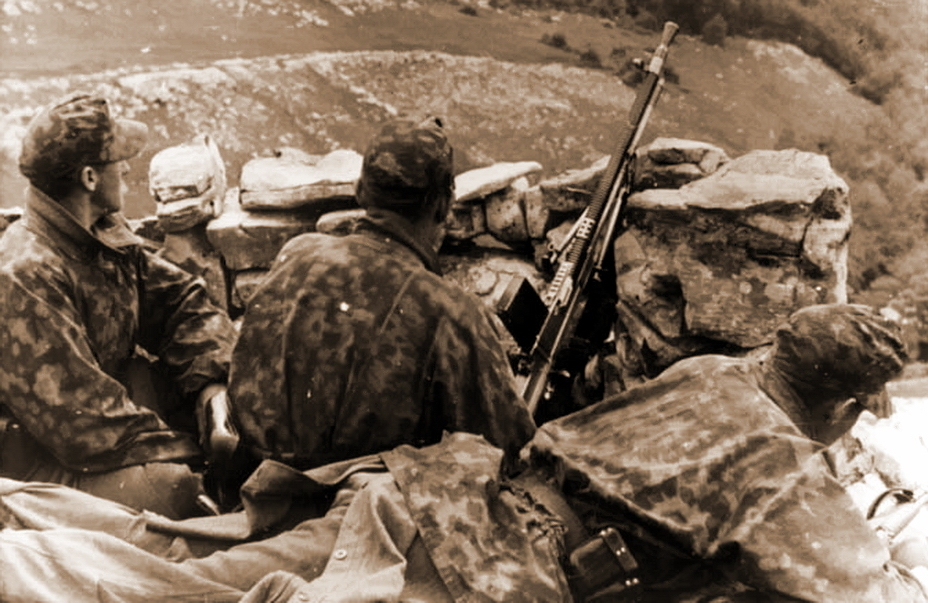
The increased popularity of assault rifles in 1943-44 was triggered by the approaching end of Nazi Germany. The excellent MG-34 was expensive and complicated to produce, and its tripod was also complicated. It was also too heavy to use as a light machinegun, as was its descendant, the MG-42. The Germans didn't manage to create an acceptable semiautomatic rifle.
This resulted in an active use of captured machineguns in the Wehrmacht of every imaginable type. The Czech ZB-26 was particularly popular, but the Germans gladly used both French Hotchkisses and Soviet Degtyaryevs. As a result, it was clear by 1943 that German infantry was starting to fall behind in density of fire at the «decisive range» of 300 meters or less against the Red Army, with its PPSh, SVT, and DPM, as well as the Americans, with their semiautomatic M1 Garand and M1 Carbine, as well as the BAR M1918A2.

Nobody is denying the fact that serious efforts to create an intermediate round in the USSR were triggered by German trophies, captured on the North-Western Front in the spring-summer of 1943, but they proceeded independently. As proof, when Hugo Schmeisser was still trying to come up with a cheaper StG 45 for the Wehrmacht in 1945, the USSR already had prototypes of a whole family of small arms for the intermediate round: bolt action and semiautomatic carbines, light machineguns, and assault rifles.
By the time that the Western Allies visited Herr Schmeisser and offered him a surrender, the USSR already had a series of Sudayev Avtomats ready for army trials, as well as its competitors from Tokarev, Degtyaryev, and many other designers. They managed it without Schmeisser in Izhevsk.
Izhevsk vs. Kovrov and stamping vs. milling
In 1946, another stage of the competition took place in the USSR. This time, Sergeant Kalashnikov took part. By then, he was an employee of the Scientific Research Small Arms Proving Grounds (NIPSVO KA) in Schurovo, where he had access not only to various captured and foreign weapons, made available through the Lend Lease program, but to experimental domestic designs, which were being tested at the proving grounds. In addition, other workers of the proving grounds, experiences and knowledgeable officers, could also share their wisdom with the young sergeant.
What follows is a well known story: after failure in the first round in 1946, Kalashnikov managed to get permission to participate in the second round, and left for Kovrov, the estate of Degtyaryev and his school, to continue working on his AK-47. If you look at a map, Kovrov is located about 900 km from Izhevsk, where Hugo Schmeisser was currently located.
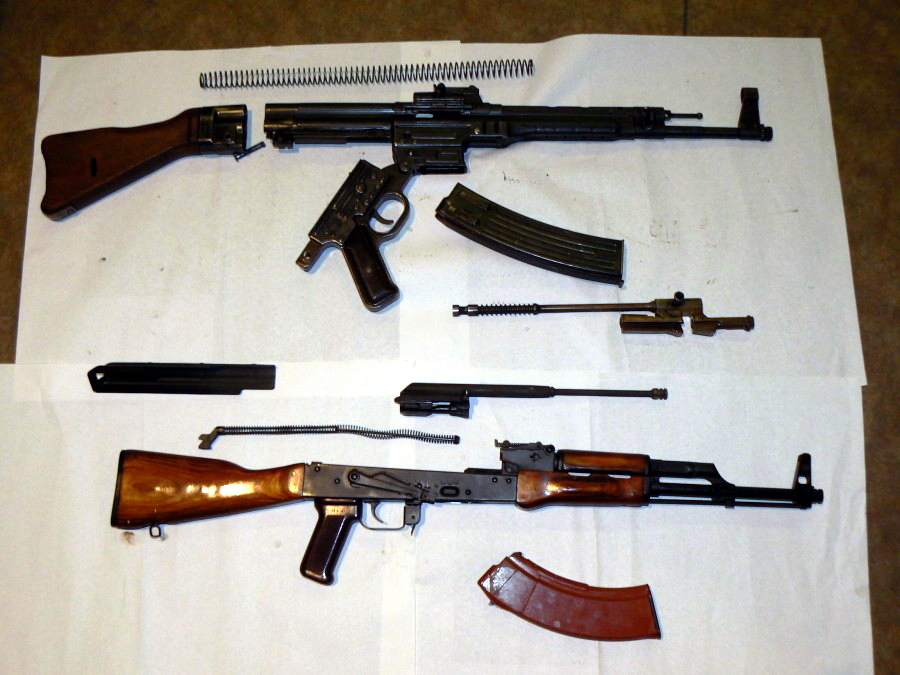
Naturally, it's hard to believe in the canonical Soviet story about one self-taught sergeant who created an excellent assault rifle from nothing. Of course, he had help, both from the designer A.A. Zaitsev, who was assigned to him in Kovrov, and from proving grounds workers. Kalashnikov (or maybe Zaitsev, it's hard to tell today) boldly borrowed successful solutions from his competitors, most likely from A.A. Bulkin. There was nothing dishonest at hand, especially since any borrowing that led to success was welcomed. Recall that all intellectual property in the USSR belonged to the people, or rather, the government. This process also happened not by personal initiative, but by suggestions from the customer.
It is impossible to detect even a passing influence of Schmeisser's contributions in the creation of the AK-47. There are just too many differences in the layout and individual components. Yes, the AK contained a number of borrowed solutions. There were very few original and completely new ideas in it, exactly the same as in the German design. Don't believe it? Compare the layout of the StG 44 and, say, the Czech ZB-26, created back in 1926. The key here is the technical and engineering solutions that unite the parts and assemblies into one whole, and here, the AK and StG are completely different.
Finally, the third act: Kalashnikov comes to Izhevsk in 1947 with his finished assault rifle to set up production. The design of the AK had settled by then. The only thing that the German specialists could have helped with at this stage was setting up mass production using stamping. There was a problem here: the Izhevsk factory was not ready for the required quality of stamping, hardening, and riveting of receivers, and Izhmash employees had to draw up a milled received in 1950. Schmeisser, a man who was dedicated to stamping, was not needed here. As a result, Hugo Schmeisser, Karl Barnitzke, and their colleagues continued to pointlessly earn their salary in the USSR for some time longer, after which they were sent home.
Who did Kalashnikov borrow from?
When talking about foreign influence on Kalashnikov's work, especially his famous assault rifle, it would be much more fair to speak of another Western arms designer: John Garand. The documentation for the SKKP (Kalashnikov-Petrov self-loading carbine) designed in 1944, plainly stated that:
«The Kalashnikov and Petrov carbine was designed following the Garand self-loading rifle pattern, as a result of which, the Kalashnikov and Petrov carbine had a number of assemblies and mechanisms that, in their design and principle of function, are analogous to those used in the Garand self-loading rifle, for example: the bolt locking mechanism, feed mechanism, trigger mechanism, and receiver attachment.»
The same report mentioned that such a locking mechanism was already used in Soviet experimental rifles, long before the USSR had the opportunity to study American self-loaders that were received through the Lend Lease program. This only serves to highlight the fact that it wasn't important who came up with an idea, but who was the first to successfully implement it.
It was Kalashnikov's own take on the bolt locking system that formed the cornerstone for future decisions made when designing the AK.
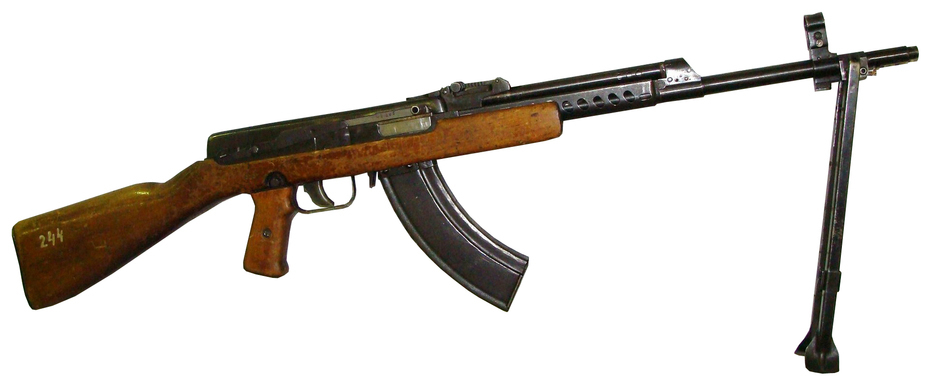
As for the borrowing done by the AK, all of the competitors were on even ground here. In addition, published documents allow us to see that some, if not all, instances of copying were done because of suggestions from proving grounds offices. For example, the phrase «altered the trigger design (using layout of Czechoslovak ZH-29 rifle)" appears twice in the list of improvements: once in regards to Kalashnikov's design, and once to describe an entry by A.A. Dementeyv from Kovrov's KB-2. Each designer was welcome to follow these recommendations or ignore them. Before the last stage of the trials, Kalashnikov's list of unimplemented suggestions consisted of three items, his closest competitor, Bulkin, missed out on five, and Dementyev, who came in last, had nine. As you can see, the possibilities were equal for everyone, but the will to follow advice was not.
Finally, concluding the topic of what in the AK came from where, let us mention one more weapon that, while not contributing any solutions directly, is a good candidate for the role of spiritual predecessor: A.I. Sudayev's submachine gun. In its creation during a tender in 1942, Aleksei Ivanovich calculated the gas blowback system's function in such a way as to give it a reserve of energy. This allowed his entrant to surpass all of its competitors in reliability, including G.S. Shpagin's very successful PPSh-2.

Kalashnikov also placed his bet on reliability. Bulkin, his chief competitor, calculated the work of his moving parts such that the recoil was minimised. This let him achieve good precision when firing from unstable positions, but left no energy in reserve for work in dirty conditions. Kalashnikov's entrant was the opposite: the bolt came back with energy to spare. This reduced precision during automatic fire, but resulted in improved function when fouled up.
As a result, Kalashnikov's assault rifle managed to meet the requirements for reliability in the last stage of the trials, and Bulkin's rifle met the requirements for precision when firing in short bursts from a bench. This was not because of any orders from above. Both designers knew that it was impossible to meet all requirements, and chose what to focus on themselves. Mikhail Timofeevich's decision to place his bet on reliability, like Sudayev did before him, was the correct choice. This choice, the choice that made the AK-47 and its descendants one of the symbols of the USSR, Russia, and the second half of the 20th century in general, was made by him, and him alone.







